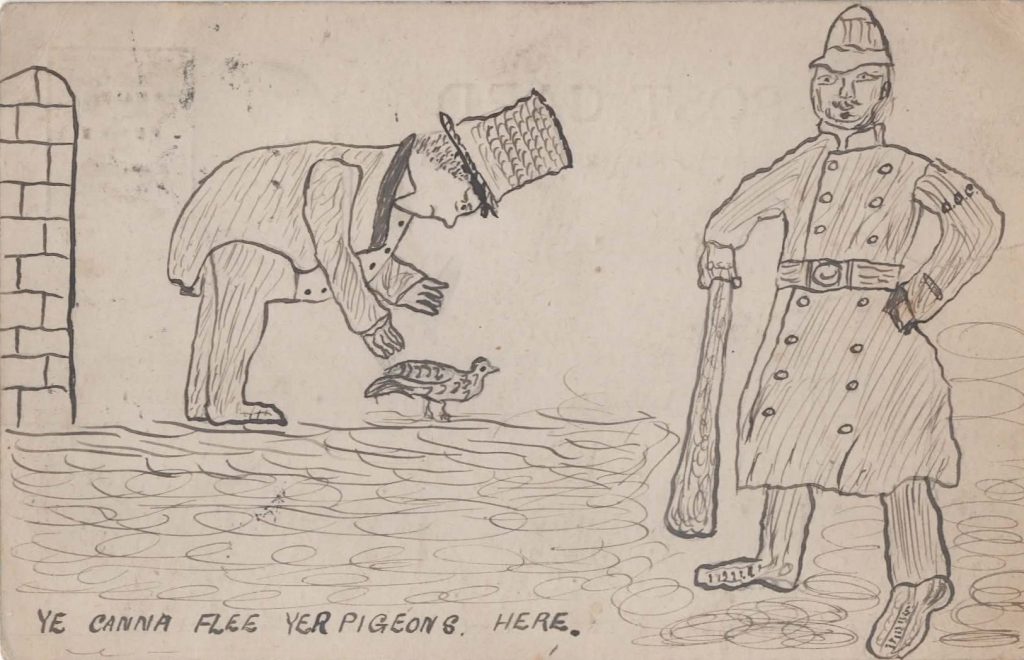
It could be said, “In 1903 you could not fly pigeons in No Place.”
***
The quote may be grammatically incorrect but the statement may be factual.
This postcard is a hand drawn one created by an unknown artist. It was mailed in County Durham on January 8, 1903. There is no message on the card other than the title “Ye Canna Flee Yer Pigeons Here.”
The illustration features a top hatted gentleman who appears to be releasing a pigeon. It seems he is also the target of a local bobby’s admonition that doing so would be against local laws. The phrase “the long arm of the law,” is generally known, although if this illustration is in proportion, we may also say the “long baton of the law!”
The card was mailed from the Durham town of Tow Law. The town is named from the Old English ‘tot hlaw’ meaning “lookout mound,” the name of a house which stood there when the place was a village.
There was rapid growth in the mid-nineteenth century after the Weardale Iron and Coal Company was established there in 1845. By 1851, blast furnaces were built, collieries were opened, and the population was about 2,000, then by 1851 the population reached 5,000. It is likely that by the time this card was posted (1903) Tow Law was a highly industrialized area and that a significant number of the miners and steel workers would be pigeon fanciers.
The card is addressed to Miss Armstrong at the Red Robin Inn, No Place, Beamish. Given the lack of any signature or message from the sender, it can be assumed that Miss Armstrong knew who would send her such a card and that the image, and its title, related to a private joke between the correspondents. It could also have been relative to a bit of local gossip.
Surely, the image was intended as humor and was poking fun at some pigeon related event which had taken place in either Tow Law or Beamish.
The place named ‘Beamish’ is likely well known to many UK readers and particularly those located in the North of England because of the world-famous open-air museum, which tells the story of life in Northeast England during the decades from the 1820s to the 1950s. It is genuinely an interesting place to visit.
The postcard was addressed to the village of “Pit Hill” which predated the museum. Pit Hill, which was once part of the sinisterly named “Hell Hole Wood,” is located about 15 miles from Tow Law, and near to Beamish is a village with the rather strange name of “No Place.”
“No Place (also known as Co-operative Villas) is a small village close to Beamish near the town of Stanley in County Durham. Some believe the name of the village was a shortening of “North Place.” It has also been suggested that the village was a border town between two places that neither wanted to include.
No Place was originally a community of just four terraced houses, but when they were demolished in 1937, nearby residents decided to take the name and rename their village.
In 1983 residents protested when the district council tried to change the name of the village back to Co-operative Villas; today road signs point to both No Place and Co-operative Villas.
The Mary Pit of Beamish Colliery, which opened in 1883, was located west of the village. The pit is remembered in the name of the ‘Beamish Mary Inn’ at No Place. The inn dates from 1897 and was previously called the Red Robin.
It was particularly pleasing to find the above information as this linked the postcard to the village and the Red Robin Inn. Unfortunately, I cannot identify the addressee Miss Armstrong even though there are several potential candidates listed in the 1901 census, none of them had occupations linked to the Red Robin Inn and no one by the name of Armstrong.
Wouldn’t it have been interesting if history had recorded more about the pigeons in No Place along with the people and events at the Red Robin Inn?
Thank you very much for the interesting article and impressive research!
I wonder how often people who went to No Place and were asked where they had gone got into conversations reminiscent of the Abbott and Costello “Who’s on first?” routine.
Aren’t the strange names a hoot? That would be an article of its on. The hand drawn postcard is awesome snd the pigeon story would be interesting, too.
This was a fun and interesting slice of the past that most of us would never have heard of outside of PCH. Thank you.